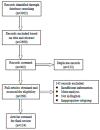Current Status of Mumps Virus Infection: Epidemiology, Pathogenesis, and Vaccine
- PMID: 32150969
- PMCID: PMC7084951
- DOI: 10.3390/ijerph17051686
Current Status of Mumps Virus Infection: Epidemiology, Pathogenesis, and Vaccine
Abstract
Mumps is an important childhood infectious disease caused by mumps virus (MuV). We reviewed the epidemiology, pathogenesis, and vaccine development of mumps. Previous studies were identified using the key words "mumps" and "epidemiology", "pathogenesis" or "vaccine" in MEDLINE, PubMed, Embase, Web of Science, and Google Scholar. We excluded the articles that were not published in the English language, manuscripts without abstracts, and opinion articles from the review. The number of cases caused by MuV decreased steeply after the introduction of the mumps vaccine worldwide. In recent years, a global resurgence of mumps cases in developed countries and cases of aseptic meningitis caused by some mumps vaccine strains have renewed the importance of MuV infection worldwide. The performance of mumps vaccination has become an important issue for controlling mumps infections. Vaccine development and routine vaccination are still effective measures to globally reduce the incidence of mumps infections. During outbreaks, a third of MMR vaccine is recommended for groups of persons determined by public authorities.
Keywords: epidemiology; mumps; pathogenesis; vaccine.
Conflict of interest statement
The authors declare no conflicts of interest exist.
Figures
References
Publication types
MeSH terms
Substances
LinkOut - more resources
Full Text Sources
Medical


